SKOVENS ARENA
A team of British architect Zaha Hadid in close collaboration with architecture and engineering consultancy Sweco and Tredje Natur architects has won the competition of ...
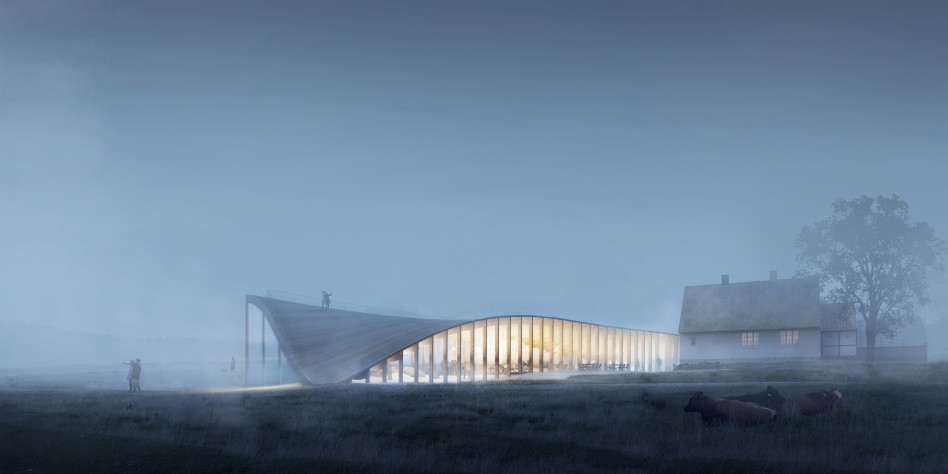
Responsible partner: Ole Schrøder
Design team: Mette Fast, Thomas Hobbs, Iryna Tsioma, Viktor Becker and Ninna Ravn
Client: Nationalpark Mols Bjerge
Project: Visitor Center Nationalpark Mols Mountains
Location: Kalø, Mols
Type: Competition
Area: 19.000 m²
Construction cost: 30 mill. Danish kroner
Team: TREDJE NATUR, Reiulf Ramstad Arkitekter, EKJ Rådgivende Ingeniører, Dark Matters and Anne Schnettler
Role: Architecture and landscape
Period: 2016
Status: Completed
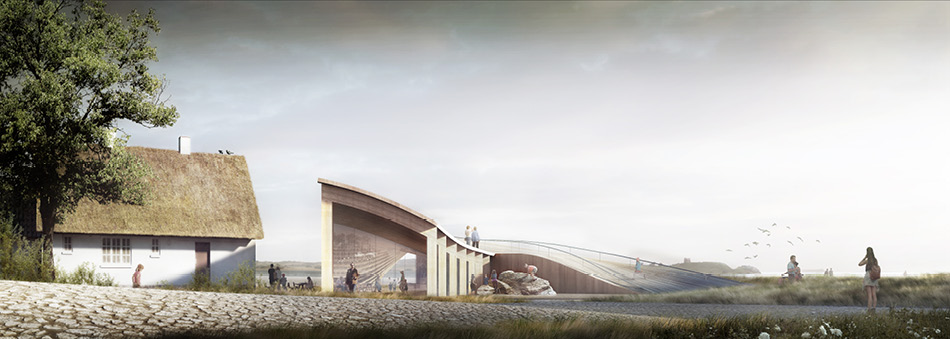
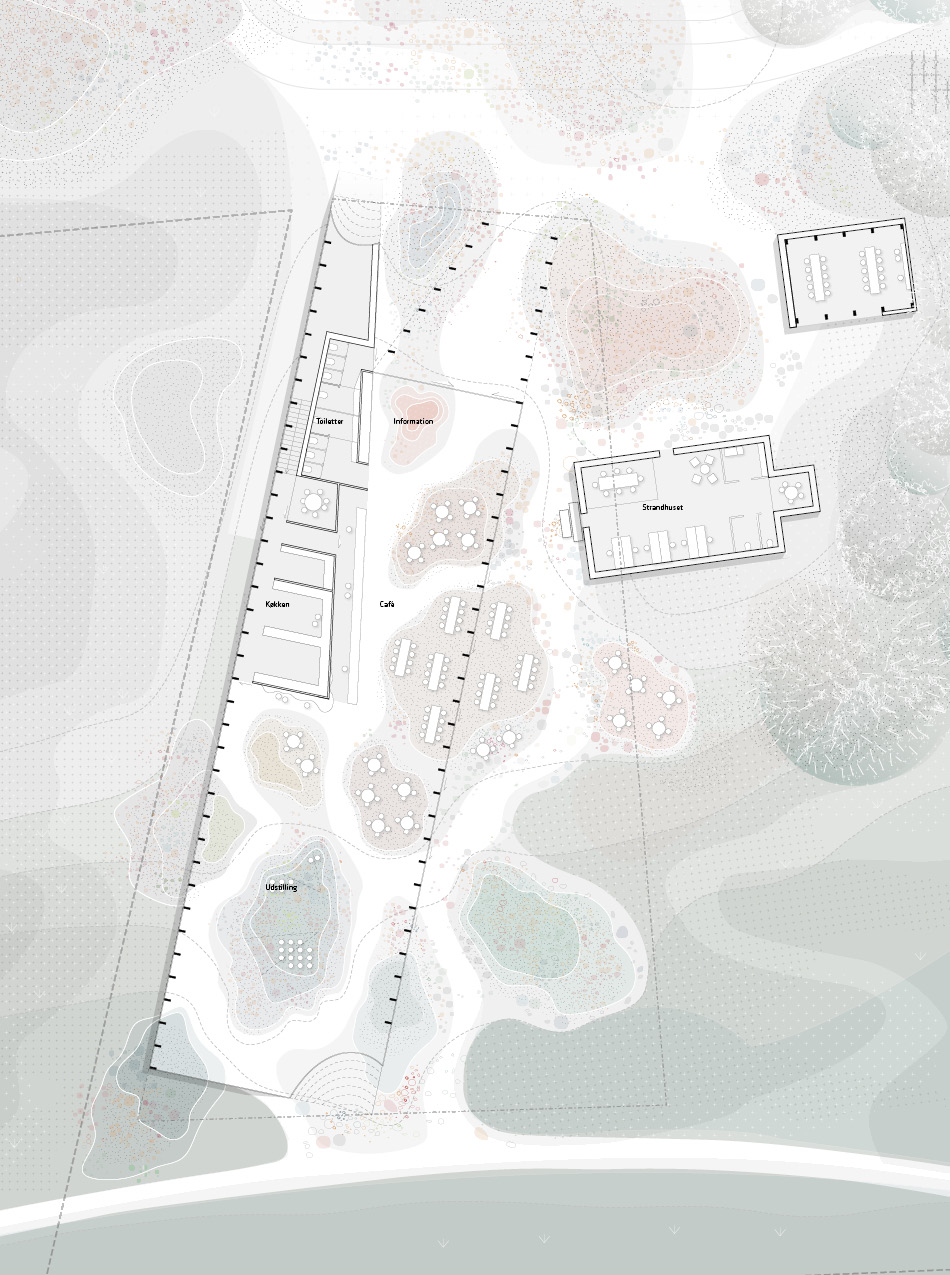
At the bottom of Kalø Vig, between past and future, the new visitor center appears from the landscape as a crucible in the transaction between four distinct landscape typologies: salt meadow, forest, pasture and fields. Together they create a magnificent scenic situation for the creation of a new visitor center at Mols Mountains. We wanted to create a visitor center that reflects the changing seasons, the local microclimate, the green and recreational routes, the wild nature, the unorganized meetings, as well as the transitions between indoor and outdoor.
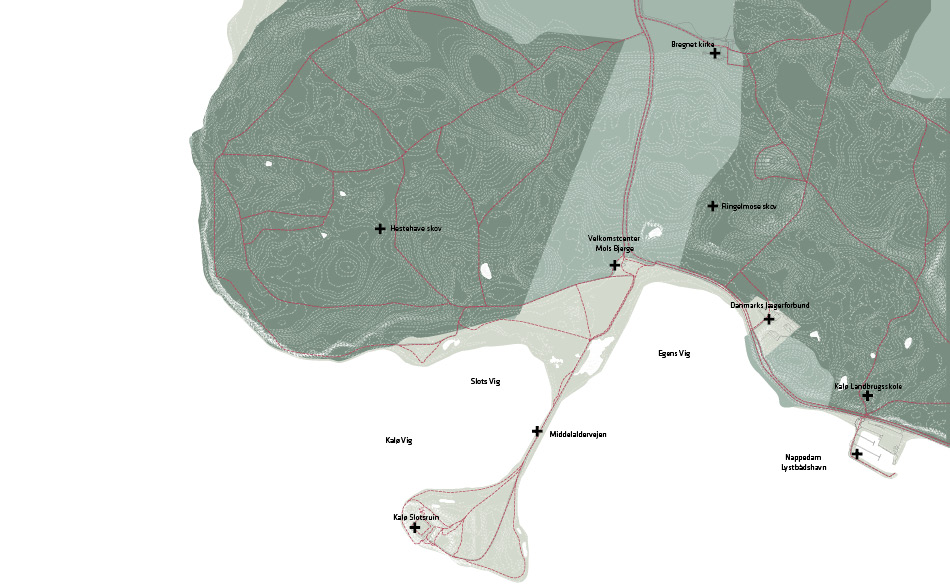
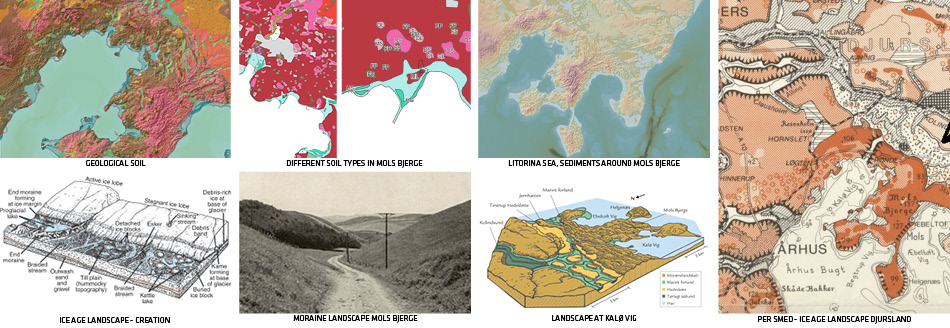
The deep valleys of Mols Mountain are created in the last ice age by meltwater and giant blocks of ice, that broke off the glacier and kept on lying there – so called kettle holes. There are many unique stones on Mols that you cannot find elsewhere in Denmark. Denmark has no granite or fells except on Bornholm. This means that the stones you can find on Mols arrived from other locations – like a geological gift from another time. Mols mountains and Kalø coastline is shaped by the landscape formations and the tongue-shaped glaciers that penetrated Eastern Jutland.
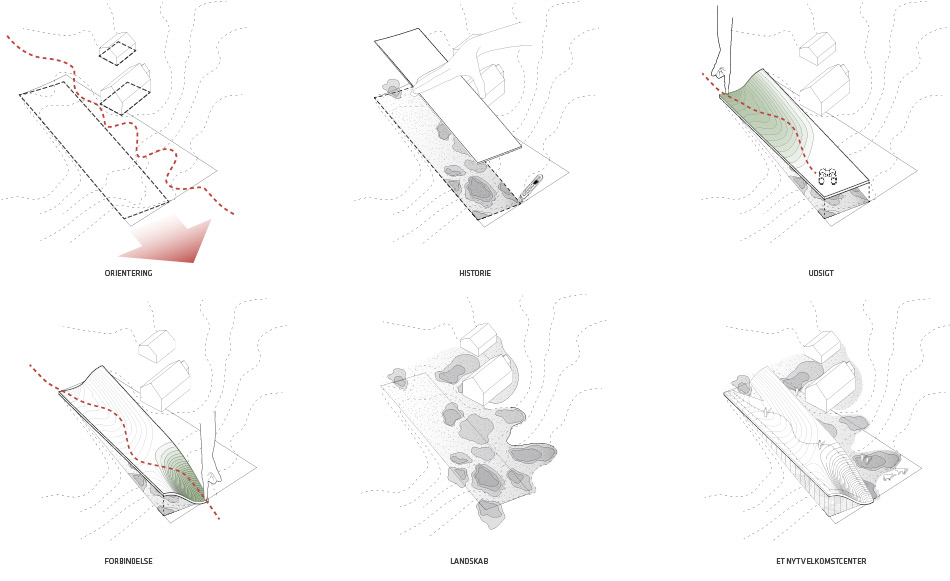
The area around Kalø is packed with different nature qualities and exciting activities. The area around the new visitor center has many natural attractions besides the ruins of Kalø castle, but together they create a special and unique area and excursion spot. A palette of nature begins south of Rønde, where Kalø castle ”puts icing on the cake” in a tale of cultural heritage, medieval and landscape formation. Ringelmose- and Hestehaveskov creates a scenic pocket where nature qualities and nature types meets.
There are several different landscape types on and around the site including: coastal landscape, marsh, grass meadow, pasture, cultivated land, forest and high growing wild vegetation.
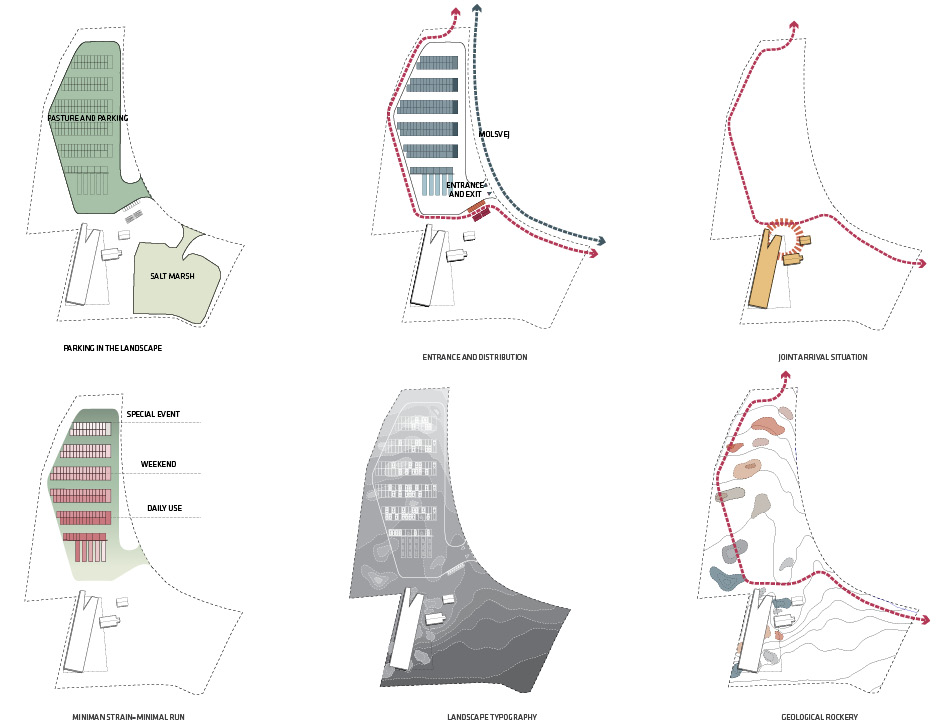
The traditional grassland appeared when the farmer sent his cattle out to the poor, rocky, steep and / or poor soils to graze. In this project, we are creating a sense of modern pasture where the cars and people are substituting the cattle as the disturbance factors that are needed to maintain the landscape while they contributes to a positive change in the growth conditions. Small hills of rocks for parking creates new microclimates for plants and animals whilst increasing the biodiversity in the area.
Our proposal puts great emphasis on the arrival situation so that the visitors and all means of transportation are surrounded by unique settings and have a good experience from the minute they arrive at the site. The parking landscape’s topography works as an organizing and distinctive landscape element that naturally leads the visitors towards the visitor center.
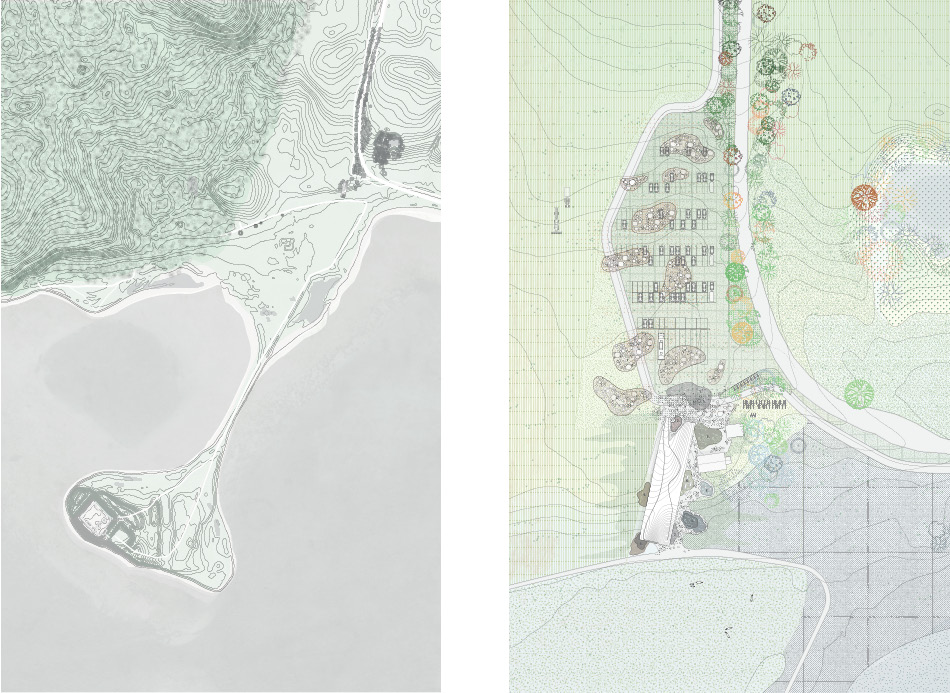
Instead of creating an architectural and national romantic tautology, we want to follow the traditions and the spirit of Hack Kampmann by creating a simple building that is able to show the grand tales in one unifying and learning landscape.
We believe that we by focusing on the grand experiences in the nature can challenge and shape the physical frames as well as the landscape. That way we can strengthen the story about Mols Mountains with a special focus on the fascinating stories of the many geological artifacts.
The project’s design has a direct and strong relationship with Mols Mountains special identity. The building is located in the landscape so that it creates the utmost relation, connection and visibility in the tension between culture and nature. The new visitor center annexes the characteristic surrounding landscape with its unique combination of local vegetation, topography and views – the sea and the Castle ruin.
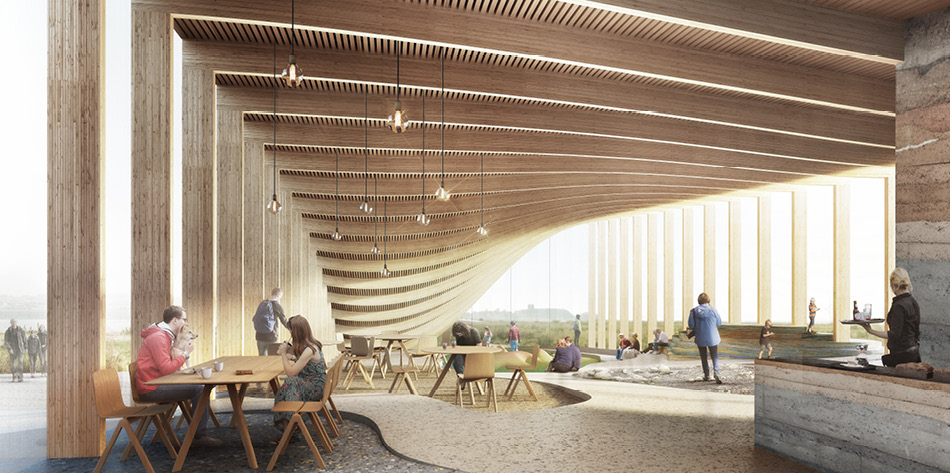
The shape of the roof is constructed by creating a clear destination and a natural vantage point for all visitors and passers-by, from which you can survey the surrounding countryside.
The history of the formation, glaciation and geology are reflected in the interior and exterior landscape through a unifying floor uniting the landscape, Strandhuset, the new visitor center and the arrival area. The new visitor center inscribes itself as a typology between building and landscape, with a volume that invites the visitors to experience and explore the area’s magnificent cultural and natural qualities.
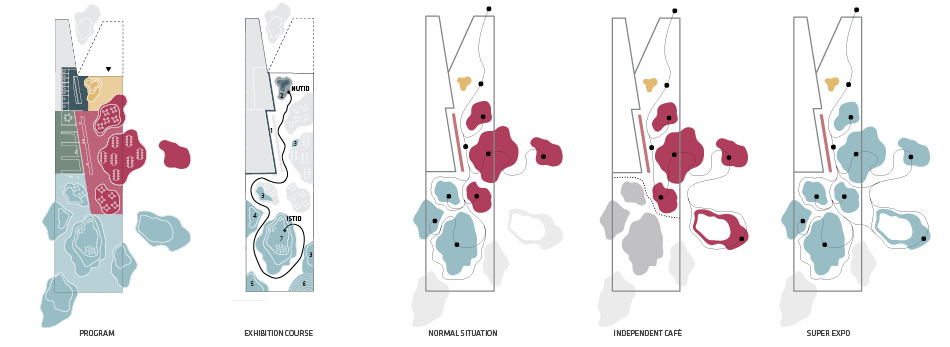
We have worked with a floating terrain, so that the body is used in a different way than in more conventionally designed exhibitions. In contrast to the sharp lines and axes that define the precise building structure, the buildings floor and coating is proposed as an indication of elevation that is controlling to the movement, exhibition, planting, accessibility and accommodation.
The communication consists of a combination of a factual timeline that is imprinted in the buildings diagonal spine and interactive experience islands. These contrasting elements form the core of the exhibition. The timeline starts at the information desk and continues to make glimpses down through the buildings island landscape. The island landscape sets focus on selected themes and culminates in an interactive glacial installation. Visitors can get their hands buried in geological and glacial traces and achieve a playful sense of the forces that were at play in the formation of the mountains.
A team of British architect Zaha Hadid in close collaboration with architecture and engineering consultancy Sweco and Tredje Natur architects has won the competition of ...
We have created 'Undergrowth' - a vision for transforming Kongelunden in Aarhus, Denmark. With Undergrowth we have made a regenerative strategy that supports nature’s ability ...
The future neighbourhood – Lynetteholm – will be a vital part of the climate- and flood protection of Copenhagen and create space for more than ...
In THE BLUE RAMPARTS, we have worked with the area Damsterdiepzone in Groningen - an area that accommodates industry, housing, and businesses. In our vision ...
Ugakei Circles is a sustainable tourism project located on the fringe of one of Japans most populated areas. The project marks a new shift towards low impact regenerative tourism
In a new grand vision for the 40-hectare future development area, Dokken in Bergen, Norway, Third Nature shows high ambitions for the regenerative city in an old logistics port and ferry terminal.
The historical Enghavepark has been transformed and is now the biggest climate project in Copenhagen. With a 22.600 m3 water reservoir, the park is answering a need to handle Copenhagen's current and future challenges with water.
The Norra Bunkeflo area in Malmö, Sweden, can become a sustainable model example for the realization of the UN's World Goals and how we can live up to the 2030 goals of the Paris Agreement.
‘New Angle’ shows how the SDG’s can be translated into practice in the construction industry. It is estimated that the project represents a CO2 saving of 30-50%.
With CPH Common House we propose the world's first upcycled high-rise building
With our master plan for Adamstuen in Oslo, we show that it is not necessary to make a compromise between building and biology in order to achieve an architectural balance in a master plan
ARKENWALK is an ambition to unite art and city with a path that anchors Arken Museum as the town’s urban generator
With the proposal `Karnappen' we have created a distinctive landmark with a green and vibrant facade for Grønttorvet in Valby, Copenhagen
The isolated Vridsløselille State Prison is rethought inside out to become an active and integrated part of the surrounding city life in Albertslund
THIRD NATURE and COWI have made a feasibility study for the City of Copenhagen, highlighting the possibilities and consequences of establishing a traffic tunnel below Åboulevarden
New Islands Brygge School has the potential to become a new and highly interconnected link between the harbor, the nature and the city
The Water Culture House integrates water activities with the cultural and popular everyday life by the harbor and creates unique and distinctive experiences
We create a new and green gathering point in Hyllie that with a station building, housing and a station square strenghtens a livable, diverse and vibrant city life
THIRD NATURE releases a groundbreaking solution to major cities' challenges with flooding, parking and lack of green spaces
With Kunskabsberget, TREDJE NATUR has designed an open, safe and flexible learning environment, with a clear local presence
Værløse Airfield has great potential for creating a grounded everyday life with nature at its core
TREDJE NATUR have created a new masterplan for “Svanemøllens Kaserne” with an understanding of the areas special history as its starting point
The station at Klostergården is a visionary infrastructural project that shows how the construction of a new station can lift up and rethink an entire neighborhood in a city
In the heart of Nordhavn lies the historic port of Copenhagen, Kronløbsøen. A new island rising from the harbour as an alluring mirage
TREDJE NATUR has together with C.F. Møller and Rambøll come up with a new holistic vision for a close sustainable Gustavsberg from the basis of the place’s original and forgotten nature.
TREDJE NATUR and C.F. Møller wins The Future Sølund. Along with Bascon, Transsolar and Smith Innovation they draw and will build one of the largest and most visionary residential projects seen in the history of Denmark
Papirøen has a unique placement in at the inner part of Copenhagen harbour. There is a lot of potential on this prime location setting the bar high on the subject of Copenhagen future city- and nature developments.
TREDJE NATUR have designed a proposal for a new pedestrian and cyclist bridge in Sydhavnen
TREDJE NATUR wins ambitious project on Nordhavn's best building site. On the tip of Redmolen surrounded by water on three sides, a prestige building and urban space is now in the making.
CBS in the city - The city in CBS! Our dogma is about developing CBS as a campus that is integrated into the city
TREDJE NATUR continues to build on the Copenhagen climate adaption plan, and joins the water investment with new strategies for nature, life and community in the city.
Vinge is not just inspired by nature, it is a city which works with nature’s processes and creates nature.
TREDJE NATUR's plan revives Bryggens Bastion with green and blue elements as the central values in the neighborhood. A connecting corridor in the project becomes the neighborhood’s new hub.
TREDJE NATUR won 2nd place in the Middelfart Climate City competition, along with Entasis and Grontmij.
TREDJE NATUR designs a collaborative platform presenting new solutions to future water challenges
Our winning proposal for the development of Almegård Barracks is based on a holistic, local concept where the main transformative force is found in the individual users and inherent qualities of the site.
Tredje Natur thinks Copenhagen’s Harbor should be a lively, accessible, productive and recreational area in the city.
The climate district in Østerbro shows the climate adaption of the future and the development of the existing city.